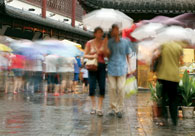
On the last day of May 2006, the skies opened up and drenched McGill’s most recent science graduates and their proud families as they celebrated spring convocation. Four days later, atmospheric and oceanic sciences and School of Environment professor Frédéric Fabry was at the National Center for Atmospheric Research (NCAR) in Boulder, Colorado, working on a way to foresee such nasty surprises.
Thunderstorms feed on atmospheric moisture levels. They’re almost impossible to predict because moisture doesn’t reflect radar waves—only condensed water in the form of rain, snow or hail does.
Fabry’s radar refractivity technique, developed with NCAR, indirectly determines moisture levels. By beaming radar signals through the same air mass, and reflecting these signals off known objects (such as buildings), it’s possible to compare how much a signal has been slowed or diffracted by atmospheric moisture. This information should allow forecasters to predict where and when sudden storms will take place, helping picnickers, baseball fans and newly minted McGill alumni alike stay dry.
This research is funded by an NSERC Discovery Grant and a Canadian Foundation for Climate and Atmospheric Sciences (CFCAS) Network Grant, with travel funding provided by the National Center for Atmospheric Research.
